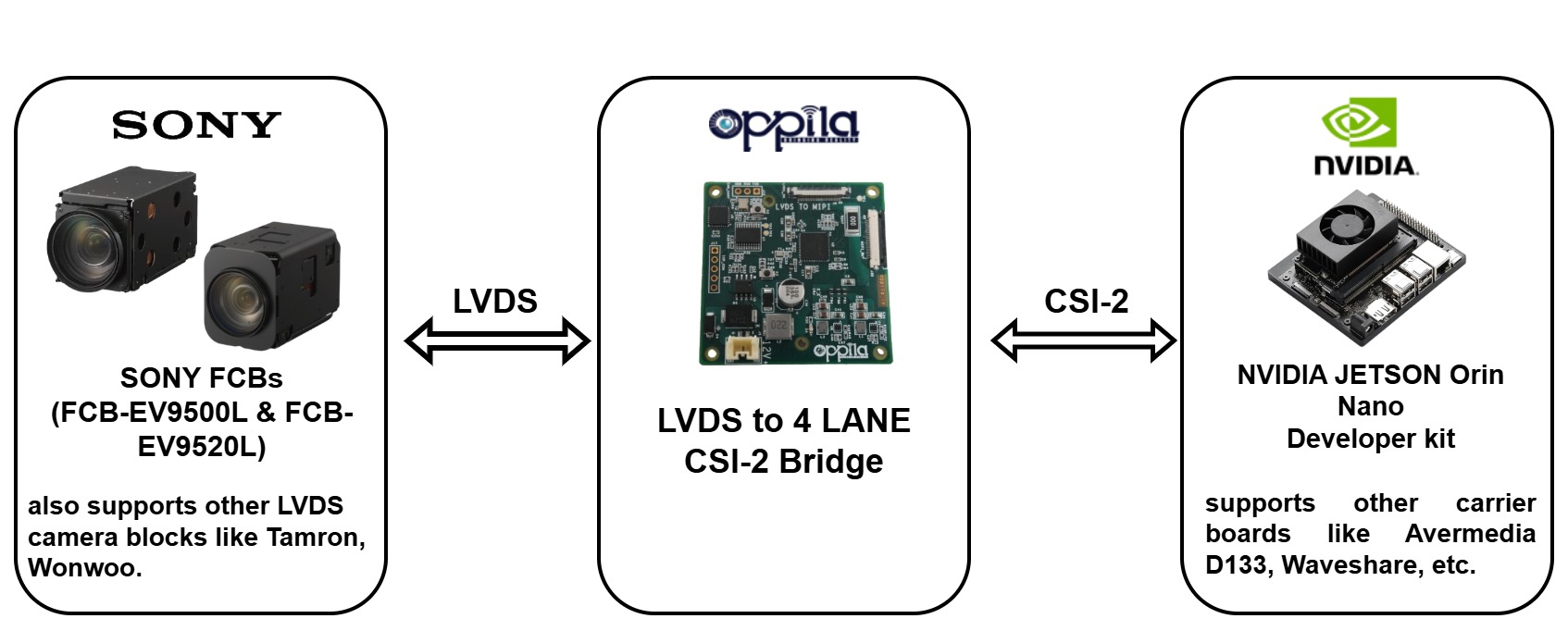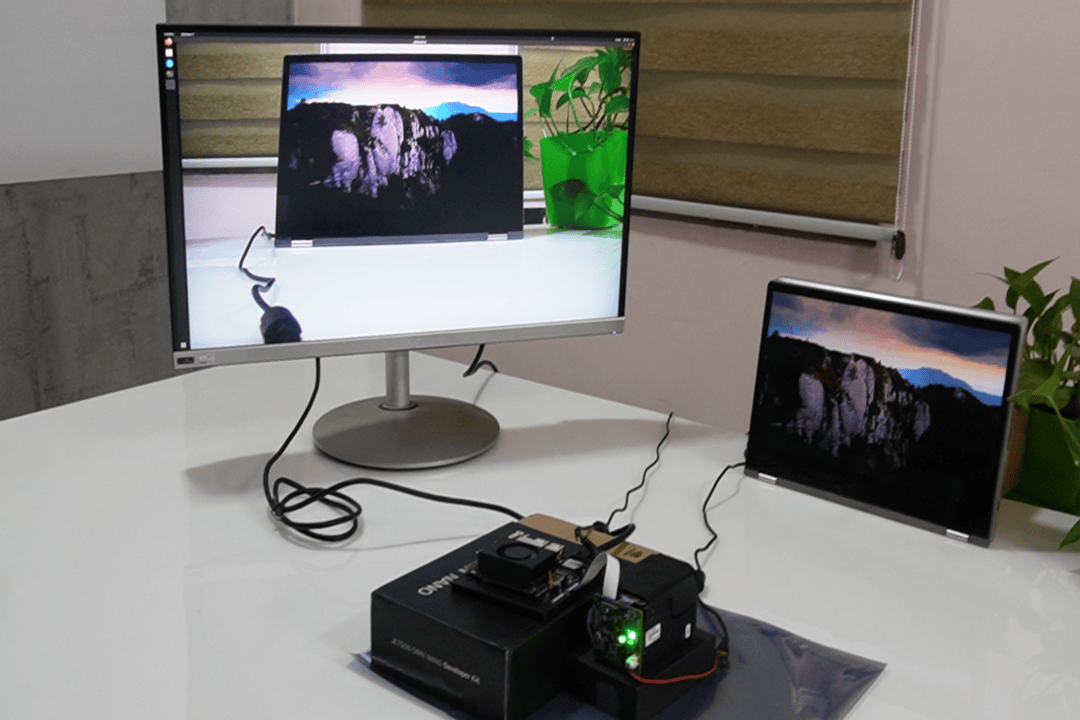LVDS to MIPI CSI-2 Bridge
Integrate Sony Functional Camera Block with NVIDIA Jetson Orin Nano Super Developer Kit
This post highlights LVDS to MIPI CSI-2 Bridge Board, designed by OPPILA, enabling Sony FCB-EV9520L / FCB-EV9500L block cameras to deliver 1080p@60fps low-latency video on the NVIDIA Jetson Orin Nano / NX Super Developer Kit.
Let’s explore how the bridge board, custom V4L2 MIPI driver and optimized GStreamer pipelines bring this seamless, real-time imaging solution for vision based AI applications.
LVDS to MIPI CSI-2 Conversion
MIPI CSI-2 employs D-PHY lanes that carry packetized data in High-Speed (HS) and Low-Power (LP) modes.
The Oppila bridge serializes the processed LVDS stream into MIPI CSI-2 format, adding required headers, ECC and CRC. With support for 4-lane output to the Jetson Orin platform, it guarantees error-free, low-power 1080p@60fps video delivery.
This board also features to control the camera from Nvidia host platform over onboard I2C to UART bridge. In this manner, the host Nvidia platform can control the camera, trigged by AI detections. Camera parameters (zoom, gain, exposure, etc.) are preset using VISCA commands over I2C - UART, ensuring a fully automated setup.
Sony FCB-EV9520L / FCB-EV9500L Cameras Block
The Sony FCB-EV9520L and FCB-EV9500L compact block cameras feature:
- 1/2.8" Exmor R CMOS sensors
- 30x optical zoom
- Native 1080p@60fps LVDS output
The EV9520L excels in low-light performance, while the EV9500L emphasizes image clarity and detail.
When paired with the Oppila LVDS - MIPI bridge, these Functional Block cameras enable low-latency MIPI streaming, making them ideal for AI applications in various domains like drones, robotics, surveillance, and medical imaging applications.
V4L2 Framework Driver Integration
Custom V4L2 driver registers the LVDS-MIPI bridge as a sub-device on Jetson Orin platforms. It builds media topology via device tree overlay, negotiates fixed 1080p60fps RAW10 input to UYVY output, and manages videobuf2-DMABUF queues for zero-copy streaming. No runtime controls (gain/exposure) exist—camera settings are preset via Sony VISCA over UART. Driver auto-detects link, handles MIPI packetization, and exposes /dev/video0. Using this video0 node, we can able to receive mipi video stream.
Key features include:
- Device Tree overlay for media topology creation.
- Negotiation of fixed 1080p@60fps RAW10 input → UYVY output.
- videobuf2-DMABUF zero-copy buffer management for optimal performance.
Once the link is detected, the driver handles MIPI packetization and exposes the video stream via /dev/video0, which can be accessed by user applications.
Hardware Connections
The setup includes:
- NVIDIA Jetson Orin Nano Super Developer Kit with Orin Nano / NX module.
- Oppila LVDS-MIPI Bridge Board with Molex 40-pin connector (54548-2272) for direct Jetson CAM1 input.
- Sony FCB-EV9520L/EV9500L camera connected via KEL 30-pin micro-coax connector (USL00-30L-A)
Power requirements:
- Bridge board: 12V DC @ 0.8 Amp
This hardware chain enables a stable 1080p@60fps RAW10 LVDS stream, converted in real-time to MIPI CSI-2 for low-latency Jetson processing.
The setup features NVIDIA Jetson Orin Nano Super Developer Kit paired, using the 54548-2272 Molex 40-pin connector for MIPI CSI-2 input on CAM1 port. Oppila LVDS-MIPI bridge board mirrors this Molex connector for direct compatibility. Connect the Sony FCB-EV9520L/FCB-EV9500L camera LVDS output via USL00-30L-A KEL 30-pin micro-coax connector using a KEL cable. This chain delivers fixed 1080p60fps RAW10 LVDS stream, converted to MIPI for low-latency Jetson processing

Real-Time Video Streaming
- Using the setup above, a 1080p@60fps real-time video stream is achieved with ultra-low latency.
gst-launch-1.0 v4l2src device=/dev/video0 ! video/xraw,format=UYVY,width=1920,height=1080,framerate=60/1 ! videoconvert ! autovideosink.
This pipeline:
- Pulls RAW10 data from /dev/video0.
- Converts it to UYVY.
- Displays directly via autovideosink with instant HDMI output.
The pipeline uses Jetson’s zero-copy buffers, achieving:
- Smooth 1080p@60fps playback
- Minimal CPU utilization
- No frame drops
For GPU-accelerated rendering, replace autovideosink with nvoverlaysink.
Encoding elements can be added for recording or network streaming.
Real-time Demo
Demo videos can be found here…
https://youtu.be/uO5r90QobQgApplications
This integration is ideal for real-time AI and vision systems requiring ultra-low latency and reliability.
Key benefits:
- No dropped frames
- Sub-millisecond pipeline latency
- Minimal CPU load
Seamless compatibility with:
- NVIDIA DeepStream SDK – Multi-stream AI analytics
- OpenCV + TensorRT – Real-time object detection & tracking
- GStreamer + Jetson Multimedia API – Zero-copy AI pipelines
Conclusion
The Oppila LVDS – MIPI CSI-2 Bridge transforms Sony’s LVDS block cameras into plug-and-play MIPI CSI-2 devices with Jetson platforms, achieving high-performance, low-latency AI applications
From image processing to high end AI applications over various domains, this solution bridges the gap between industrial-grade LVDS cameras and modern embedded vision systems like Nvidia platforms

